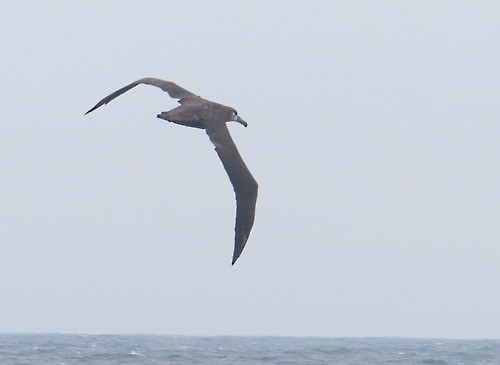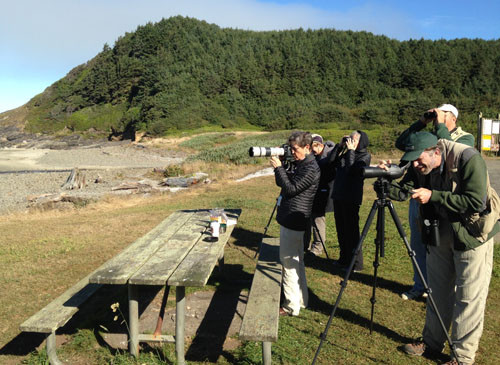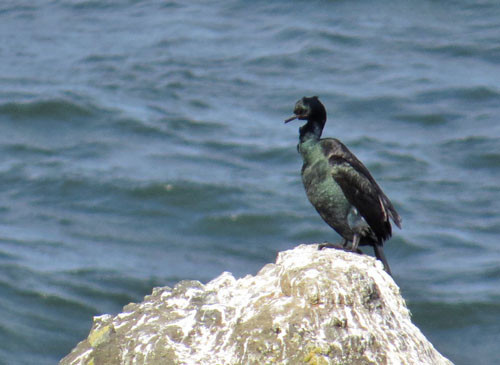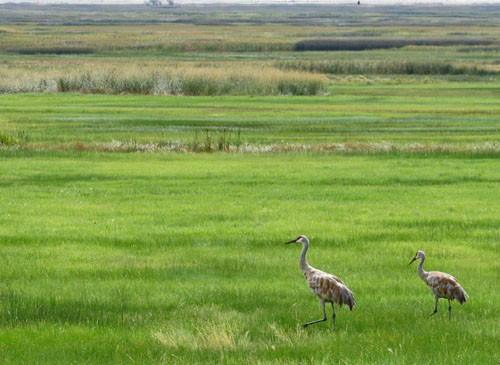 Black-footed Albatross is one of the expected species some 20 miles from shore on our pelagic extension.
Photo: Rich Hoyer
Black-footed Albatross is one of the expected species some 20 miles from shore on our pelagic extension.
Photo: Rich Hoyer Oregon is well known for lush ancient forests and a picturesque coastline that teems with waterbirds. This is the Oregon west of the Cascade Mountains, where most of the human population resides. Less well known are the radically different habitats and climates as one moves south and east. In the “rain shadow” of the Cascades one finds dry open conifer forests, desert-like shrub-steppe, and stark vistas of canyons and fault-block mountains, while farther south one experiences warm summers with virtually no rain. It’s this meeting of Pacific, Continental, and Mediterranean climates in astonishingly close proximity that gives the state of Oregon an avian diversity greater than any other area in the world at a similar latitude—especially in woodpeckers and owls. We’ll explore most of this diversity in scenic state parks on the coast, vibrant national wildlife refuges in the Willamette Valley, extensive coniferous forests on both sides of the Cascades, and open expanses of sagebrush in the eastern deserts.
Main Tour
Day 1: The main trip begins at 6 p.m. in Portland. Night in Portland.
Excellent birding opportunities and great leadership from Rich Hoyer. He knows the birds, where and how to find them and how to get us on them. Rich also shared is knowledge and enthusiasm for other wildlife - butterflies, other insects, mammals and snakes (we had a great experience with a gopher snake), and as well how the forest and desert environments work and the geology of Oregon. I learned a lot! Our breakfast and lunch picnics were excellent, with healthy choices and enough variety. Rich made us a chocolate mousse treat one day!
The pelagic day was outstanding! The boat and crew did a great job getting us out to the birds and back safely. Bird spotters, including Rich, helpied us identify and learn about the birds. We had amazing numbers of some species and a surprise Great Shearwater, which was on the wrong ocean!
Dixie Sommers, Sept. 2018
Day 2: We’ll begin the tour heading south from Portland up the Willamette Valley, a major trough for the river of the same name that flows north between the Coast Range and the Cascades. Although it is the most agriculturally productive region in the state (with such diverse crops as wine grapes, irises, berries, filberts, grass seed, and Christmas trees), large stretches of riverine forest are well protected, and three major national wildlife refuges (Baskett Slough, Ankeny, and Finley) are within driving distance of each other. California Scrub-Jay, Black-headed Grosbeak, Violet-green Swallow, and Vaux’s Swift are examples of common breeding species, and the improved wetlands at the refuges have recently hosted such surprises as Black-necked Stilt, and breeding Wilson’s Phalarope and Black Tern. The large cottonwoods and riparian thickets along the Willamette River and its tributaries are home to Pileated Woodpecker, Willow Flycatcher, and the sometimes spotless oregonus race of Spotted Towhee. Night in Corvallis.
Day 3: Early this morning we’ll drive to the meadow-capped top of Mary’s Peak, at 4,097 feet the highest point in the Coast Range, where one can often see and sometimes even hear the Pacific Ocean 27 miles away. Northern Pygmy-Owl, Gray Jay, Red-breasted Sapsucker, and Varied Thrush are some of the forest birds we might see, but our main targets are the elusive Sooty Grouse and Mountain Quail. Both are actually common here though hard to see; late summer is the best time to look for them. Later in the day we’ll visit valley refuges and the requisite sewage ponds for migrant water birds. An evening outing to a nearby forest should yield Western Screech-Owl and possibly also Barred Owl. Night in Corvallis.
Days 4-5: Shorebird migration will be in full swing, so we’ll head a bit south and west to Florence and spend the next two days on the stunningly beautiful and rightfully famous Oregon Coast. From towering headlands and rocky shores we’ll spot Western Gull, Brandt’s and Pelagic Cormorants, and Surf Scoters while keeping an eye out for the scarce Black Oystercatcher, Black Turnstone, Surfbird, and Wandering Tattler. Amongst the scoters we may spot Rhinoceros Auklet, Marbled Murrelet, and Red-necked Grebe. We’ll check estuaries and mudflats for concentrations of migrant shorebirds which could include Western, Least, Baird’s, and Pectoral Sandpipers, loons, and Heermann’s Gulls. Nights in Florence.
Day 6: Today we head east over the Cascade Mountains. Following the Willamette River into the western foothills of the Cascade Mountains, we’ll stop to admire the lovely, rushing mountain streams while eyeing the boulders for American Dippers. A short stroll through a grove of ancient Pacific Silver Fir, Douglas-fir, and Western Hemlock could reveal mixed flocks including Brown Creeper and Golden-crowned Kinglet. As we climb the higher mountains and cross the divide, the habitat changes abruptly and dramatically, from a dripping, dense fir-hemlock rainforest to Lodgepole Pine on lava flows only a few thousand years old, to a dry, open Ponderosa Pine–Western Juniper woodland punctuated by willow- and aspen-lined streams. In these drier east-side forests we could see Red-naped Sapsucker, Pygmy Nuthatch, and Green-tailed Towhee. Five species of chipmunk are possible (though telling them apart is a challenge), and if it’s warm enough we could see some delightful butterflies, such as Golden Hairstreak and Lorquin’s Admiral, and bright blue-tailed Western Skinks are common here. Night in Christmas Valley.
Day 7: The primary birding area for this morning is the landlocked basin of Summer Lake, where numbers of gulls, avocets, stilts, and phalaropes breed and stage on their migrations. Some years the numbers of birds are staggeringly high, and we hope to witness such an unparalleled spectacle. Migrant shorebirds are also in evidence here, and we’ll especially be on the lookout for the locally breeding Snowy Plover. After a picnic lunch in the nearby hills we’ll drive past the impressive Abert Lake basin located below the rim of the same name on our way to the next hotel. Night in Burns.
Days 8-10: We’ll have three full days to explore the watersheds of the Harney Basin. Malheur National Wildlife Refuge, which encompasses the heart of this landlocked basin as well as the Donner und Blitzen river valley to the south, is located only 30 miles south of Burns. Well before we actually arrive at the refuge we’ll be birding along the route south of town. Water levels can vary greatly from year to year, but with luck roadside stops will feature ponds and lakes with many species of ducks, Clark’s and Western Grebes, and Wilson’s Phalaropes. Swainson’s Hawks will be thinking about their southward migration, and arctic-breeding Gambel’s White-crowned Sparrows will already be arriving. We’ll check the wildlife refuge headquarters, an oasis of spruce, pine, cottonwood, and elm, as well as other groves of trees such as Benson Pond and P Ranch. These isolated groves in a sea of sagebrush act as migrant traps in spring and fall, and there’s usually a family group of Great Horned Owls roosting in the trees at one of them. We’ll also check the dry upland habitats for sage and juniper specialties such as Sage Thrasher and Sage Sparrow, and we can always hope for a wandering Sage Grouse on the roadside as we also keep an eye on the cliffs and rimrock for White-throated Swift and Chukar. One of the tour highlights will be our drive to the top of wonderfully scenic Steens Mountain, a fault block mountain with Oregon’s highest road at 9,500 feet, not passable before about July 4 each year due to snow. The view of the Alvord Basin, Oregon’s driest desert, stretching 5,600 abrupt feet below, is awesome. We even have a chance of seeing Black Rosy-Finch in its only known breeding location in the state, as well as an isolated introduced population of Bighorn Sheep.
On the day between trips south to the refuge we’ll venture north into the Silvies River drainage in the superb pine-fir-larch woods of the Ochoco and Blue Mountains. Here we have an excellent chance of finding Williamson’s Sapsucker, White-headed Woodpecker, Clark’s Nutcracker, and Red Crossbill, among many other species. We’ll also make an evening visit here to look for Flammulated Owl, which though difficult to see well can be surprisingly common. Nights in Burns.
Day 11: Our drive back to Portland will take us west and north along the scenic John Day River, the second-longest free-flowing river in the lower 48 states. Stops along the way may reveal breeding birds of the coniferous forests such as Lewis’s Woodpecker and Townsend’s Warbler, and we’ll include a visit to the John Day Fossil Beds National Monument visitor center. Once we reach the freeway east of The Dalles, we’ll head downriver through the rightfully famous Columbia River Gorge National Scenic Area, where the continent’s second-largest river cuts right through the Cascade Mountains, and waterfalls and windsurfing opportunities attract many tourists. We’ll have our farewell dinner at the historic Multnomah Falls Lodge in view of the tallest falls in the nation before continuing to Portland. Night in Portland.
Day 12: The main trip concludes this morning in Portland.
Newport Post-Tour Pelagic
Day 1 (12): The post-trip extension begins as we leave from our hotel in Portland in the morning and start the three-hour drive to Newport, birding along the way. Once at the coast we’ll have dinner, stock up on lunch and snacks for the boat trip and check into our hotel. Night in Newport.
Day 13: We’ll get to the Newport harbor early in the morning for our all-day boat trip, which departs around 7:00 a.m. As soon as we leave the jetties of the Yaquina River behind, we could start seeing nearshore species such as Common Murre and Pigeon Guillemot, and we’ll make a special effort to look for Marbled Murrelet as well as mammals such as Gray Whale. We’ll then motor for a couple more hours to the edge of the continental shelf, stopping whenever we see birds, such as the likely Sooty and Pink-footed Shearwaters. At the farthest point we should see Black-footed Albatross, migrant jaegers (all three species are possible), Arctic Tern, and both Red and Red-necked Phalaropes. We’ll be back in port by about 3:00 p.m., finishing the day with our drive back to Portland. Night in Portland.
Day 14: The tour concludes this morning at the Portland Airport area hotel.
Updated: 27 September 2023
Prices
- (2025 - Not Yet Determimed)
Notes

Questions? Tour Manager: Sara Pike. Call 1-866-547-9868 (US or Canada) or (01) 520-320-9868 or click here to email.
* Tour invoices paid by check carry a 4% discount. Details here.
This tour is limited to seven participants with one leader.



